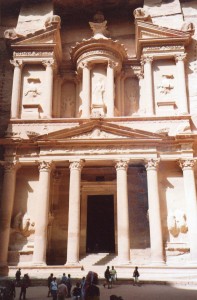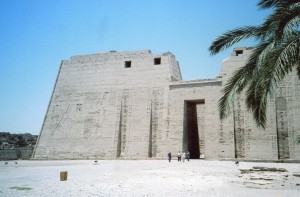I found Petra as breathtaking as the pyramids at Giza. No photograph comes close to capturing it–please pardon my own humble efforts. What’s so special about this place?
The Treasury, pictured here, provides one clue. It was actually a tomb. It elegantly adapts Greco-Roman architecture, but blends it with gods from other cultures, including who most scholars consider to be Egypt’s Isis. She was connected with the afterlife, and her cults became popular in Rome too–you can see her temple in Pompeii. Petra’s Treasury reflects a multicultural society that had become very wealthy. Its builders were called the Nabateans, and research is showing that they had a special culture in the ancient world.
The Nabateans grew wealthy as traders in the last three centuries BCE. The world was becoming more integrated than ever. Rome and Han China grew to dominate both ends of the known world. The Kushanas built an empire that covered much of India and Central Asia. The Silk Road linked all three areas, and people had discovered how to sail in the open seas around the Indian Ocean with the annual monsoon–they no longer had to hug the coasts. In this world of increasing international trade, the Nabateans had things a lot of people wanted.
Frankincense and myrrh grow in the Arabian Peninsula’s southwestern mountains. Frankincense is a white gum resin that seeps from cuts made in small trees. It also grows in east Africa, but it’s an inferior grade. Arabia’s is pure. It burns with a luminous and fragrant white smoke. It surely pleases the gods, carries prayers to heaven, and purifies temples and homes.
Myrrh was also used as incense, and for medicine, perfume and, in Egypt, embalming. Since Rome, Egypt and India had large populations with prolific religious imaginations, these two products comprised a major industry.
And since the world was becoming more linked than ever, the Nabateans were about to get an explosion of cultural influences, and synthesize one of the most fascinating ancient societies.
You can read more in Facts and Maybes about Petra, Part Two.



Comments on this entry are closed.